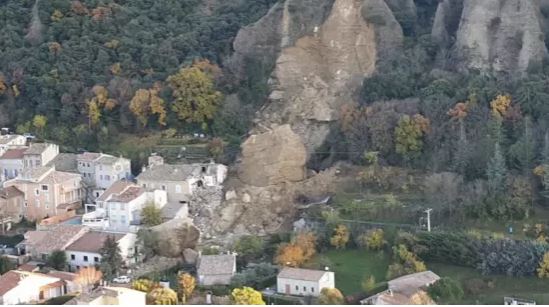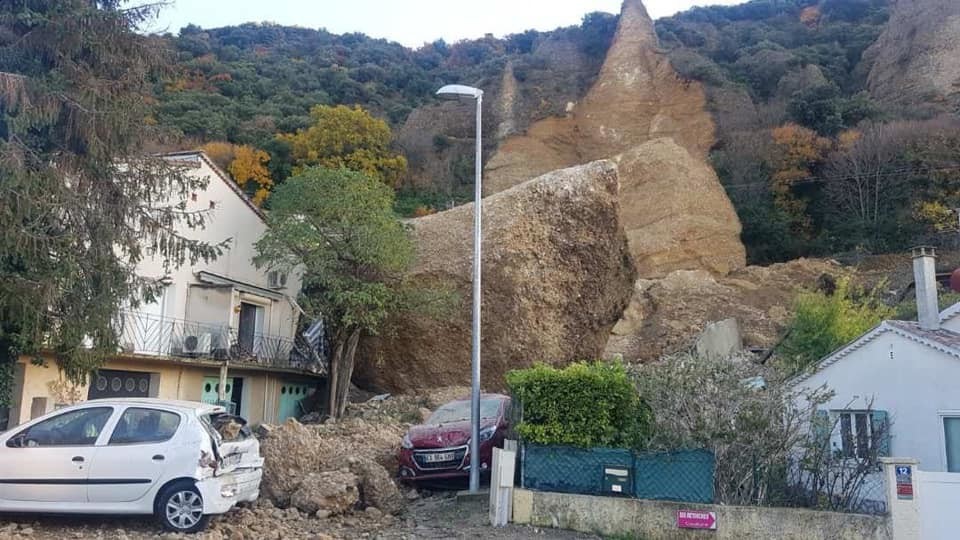4 December 2019
Les Mees: a spectacular and unusual rockfall in France
Posted by Dave Petley
Les Mees: a spectacular and unusual rockfall in France
On 2 December 2019 a spectacular rockfall occurred above the village of Les Mees in Alpes de Haute Provence, France. The failure, which was triggered by the exceptional rainfall that has occurred through the autumn, is reported to have developed on a steep rock bluff known as Les Pénitents (although judging by the imagery I suspect it actually occurred on an adjacent bluff rather than Les Pénitents themselves). The blocks, which must weigh over a thousand tonnes, destroyed a house:-

The aftermath of the 2 December 2019 rockfall at Les Mees. Image via L’Obs / AFP.
.
Note the very large block at the toe of the slope and the smaller, but still very substantial block 50 m or so further down the slope.
The landslide occurred at 4:15 pm local time. Fortunately the occupants of the destroyed property were at work, so no fatalities occurred. The Twitter account @ALERTES_INFO tweeted this image of the aftermath of the rockfall, taken from the road. This is the smaller of the two blocks, with the larger one being visible in the background:-

Devastation caused by the 2 December 2019 rockfall at Les Mees in France. Image tweeted by @ALERTES_INFO.
.
Les Pénitents are a set of geological columns that sit above the ancient village of Les Mees, named for their resemblance to a group of monks wearing pointed hoods. The rocks are eroded columns formed from the Valensole Formation, a Miocene and Pliocene conglomerate formed from subalpine debris. The images suggest that the rock mass has few discontinuities such as joints, which both allow it to form these large pillars and enable the detachment of large, coherent blocks when failures occur. In this case, large rockfalls are likely to be comparatively infrequent but to have very high potential cost.
This rockfall is likely to present an interesting hazard management challenge for the village. Determining the likelihood of a failure of this type will not be straightforward, but as the images above show the consequences could be substantial. Clearly catching or retaining such a boulder is difficult, and modifying the rock mass is likely to be unacceptable.


 Dave Petley is the Vice-Chancellor of the University of Hull in the United Kingdom. His blog provides commentary and analysis of landslide events occurring worldwide, including the landslides themselves, latest research, and conferences and meetings.
Dave Petley is the Vice-Chancellor of the University of Hull in the United Kingdom. His blog provides commentary and analysis of landslide events occurring worldwide, including the landslides themselves, latest research, and conferences and meetings.
I found a Google Streetview of the damaged home from prior to the rockfall at:
https://www.google.ca/maps/@44.028181,5.9739047,3a,75y,157.74h,100.21t/data=!3m6!1e1!3m4!1skoz2lNsqbeVXOmUAv1D9dA!2e0!7i13312!8i6656
The home was essentially wiped off the face of the Earth!
Hello
RTM-ONF and Cerema carried out the emergency site inspection.
A large mass (approximately 2000 m3) completely cracked will have to be purged, which will prolong the evacuation of security. The water and electrical networks, destroyed by the landslide, are being repaired.
Pierre AZEMARD – Cerema Méditerranée
I like knowing about geological events
that happen around the world. Your reports give me
perspective on the infinitesimal place and time
I occupy in this firmament. They reassure me,
engender outpourings of compassion, and spark
awe for the unimaginable forces we swim in.
The work being done on this website
is important and far-reaching and I am grateful
for it.